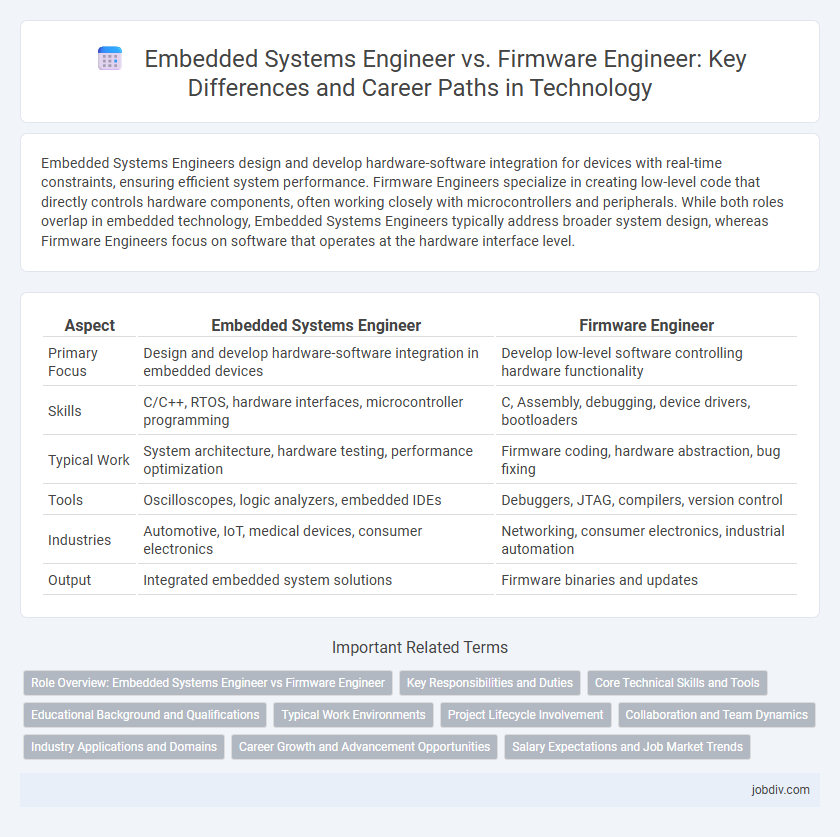Embedded Systems Engineers design and develop hardware-software integration for devices with real-time constraints, ensuring efficient system performance. Firmware Engineers specialize in creating low-level code that directly controls hardware components, often working closely with microcontrollers and peripherals. While both roles overlap in embedded technology, Embedded Systems Engineers typically address broader system design, whereas Firmware Engineers focus on software that operates at the hardware interface level.
Table of Comparison
| Aspect | Embedded Systems Engineer | Firmware Engineer |
|---|---|---|
| Primary Focus | Design and develop hardware-software integration in embedded devices | Develop low-level software controlling hardware functionality |
| Skills | C/C++, RTOS, hardware interfaces, microcontroller programming | C, Assembly, debugging, device drivers, bootloaders |
| Typical Work | System architecture, hardware testing, performance optimization | Firmware coding, hardware abstraction, bug fixing |
| Tools | Oscilloscopes, logic analyzers, embedded IDEs | Debuggers, JTAG, compilers, version control |
| Industries | Automotive, IoT, medical devices, consumer electronics | Networking, consumer electronics, industrial automation |
| Output | Integrated embedded system solutions | Firmware binaries and updates |
Role Overview: Embedded Systems Engineer vs Firmware Engineer
Embedded Systems Engineers design and develop integrated hardware-software solutions for specialized computing devices, emphasizing system architecture and real-time operating systems. Firmware Engineers focus on programming low-level code that directly interfaces with hardware components, ensuring efficient device functionality and performance at the microcontroller level. Both roles require expertise in C/C++ programming, but Embedded Systems Engineers often have broader responsibilities involving hardware integration and system optimization.
Key Responsibilities and Duties
Embedded Systems Engineers design and develop integrated hardware and software solutions for real-time applications, focusing on system architecture, microcontroller programming, and hardware interfacing. Firmware Engineers specialize in writing low-level code that controls hardware functions, debugging firmware on embedded devices, and optimizing performance for specific hardware platforms. Both roles require expertise in C/C++, real-time operating systems (RTOS), and hardware debugging tools, but Embedded Systems Engineers typically engage more with system integration and hardware design, while Firmware Engineers concentrate on code development and hardware-software interaction.
Core Technical Skills and Tools
Embedded Systems Engineers specialize in hardware-software integration, proficient in microcontroller programming, real-time operating systems (RTOS), and low-level coding languages like C and Assembly. Firmware Engineers focus on developing and debugging firmware using tools such as JTAG debuggers, oscilloscopes, and Integrated Development Environments (IDEs) like Keil or IAR Embedded Workbench. Both roles require strong understanding of communication protocols like SPI, I2C, and UART, but Embedded Systems Engineers often engage more with hardware design and timing constraints.
Educational Background and Qualifications
Embedded Systems Engineers typically hold a degree in Electrical Engineering, Computer Engineering, or Computer Science, emphasizing microcontroller architecture, real-time operating systems, and hardware-software integration. Firmware Engineers often possess qualifications in Computer Engineering or Software Engineering, with specialized knowledge in low-level programming languages such as C and assembly, alongside proficiency in debugging and developing firmware for embedded devices. Both roles require strong analytical skills and familiarity with embedded development tools, but Firmware Engineers usually have deeper expertise in software development lifecycle and hardware abstraction layers.
Typical Work Environments
Embedded Systems Engineers typically work in environments involving real-time operating systems, microcontrollers, and hardware-software integration, often within automotive, aerospace, or industrial automation sectors. Firmware Engineers primarily focus on low-level software development for embedded devices, collaborating closely with hardware teams in labs or manufacturing facilities to optimize device performance and reliability. Both roles require hands-on experience with debugging tools, prototyping equipment, and version control systems in specialized technical environments.
Project Lifecycle Involvement
Embedded Systems Engineers engage in the entire project lifecycle, from initial hardware design and integration to system testing and deployment. Firmware Engineers primarily concentrate on the development, debugging, and optimization of low-level software that directly controls hardware components. Both roles require close collaboration during the prototyping and validation phases to ensure seamless hardware-software interaction.
Collaboration and Team Dynamics
Embedded Systems Engineers and Firmware Engineers collaborate closely to design and implement integrated hardware-software solutions, ensuring seamless device functionality. Effective team dynamics hinge on clear communication of hardware constraints and software requirements, allowing firmware to efficiently interface with embedded components. Cross-disciplinary expertise and iterative feedback loops drive innovation and reduce development cycles, enhancing product performance in embedded technology projects.
Industry Applications and Domains
Embedded Systems Engineers design and develop integrated hardware-software solutions for automotive, aerospace, and medical devices, emphasizing system-level optimization and real-time performance. Firmware Engineers specialize in low-level software development for microcontrollers and embedded processors, primarily in consumer electronics, industrial automation, and IoT devices, focusing on code efficiency and hardware interfacing. Both roles are critical in industries requiring robust, reliable embedded solutions, but Embedded Systems Engineers work more broadly across the entire system architecture while Firmware Engineers concentrate on the embedded software layer.
Career Growth and Advancement Opportunities
Embedded Systems Engineers often experience broader career growth by working on hardware-software integration projects, developing expertise in microcontrollers and real-time operating systems, which opens paths to senior design and systems architecture roles. Firmware Engineers specialize in low-level software development for hardware devices, with advancement focused on mastering embedded programming languages, debugging tools, and protocol stacks, leading to positions such as lead firmware developer or embedded software manager. Both careers offer opportunities to transition into product management or technical consulting, but Embedded Systems Engineers typically benefit from a wider scope of hardware-related innovation and system-level design challenges.
Salary Expectations and Job Market Trends
Embedded Systems Engineers typically command salaries ranging from $75,000 to $120,000 annually, reflecting their roles in designing integrated hardware-software solutions for real-time applications. Firmware Engineers, specializing in low-level software development for device control, often earn between $80,000 and $130,000, benefiting from increasing demand in IoT and automotive sectors. Job market trends indicate robust growth for both professions, with firmware engineering showing slightly higher expansion due to the surge in connected devices and smart technology innovation.
Embedded Systems Engineer vs Firmware Engineer Infographic

 jobdiv.com
jobdiv.com